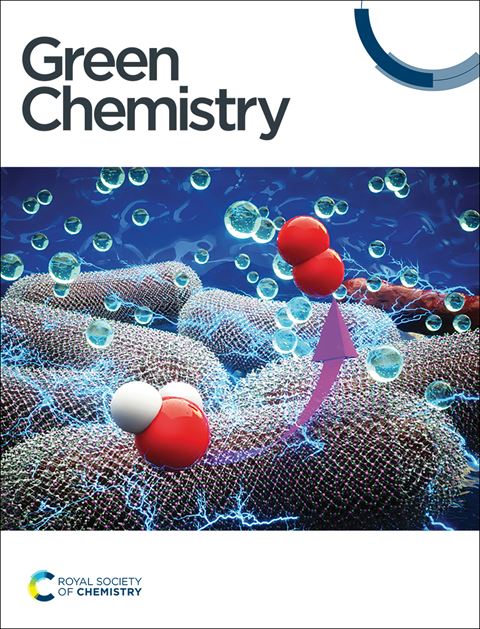木质素衍生的联苯二聚体在恶臭假单胞菌KT2440†中转化为5-羧基香草酸
IF 9.3
1区 化学
Q1 CHEMISTRY, MULTIDISCIPLINARY
引用次数: 0
摘要
设计新的生物催化剂,将木质素解聚衍生的二聚体转化为增值化合物是目前生物木质素增值的主要挑战。联苯5,5 ‘ -脱氢双苯甲酸酯(DDVA)是一种模型木质素二聚体,含有木质素解聚混合物中常见的C5-C5 ’键。在这项工作中,通过表达合成的DNA模块,拓宽了工业相关的恶臭假单胞菌KT2440菌株的代谢潜力,这些DNA模块编码了Sphingobium lignivorans SYK-6菌株的DDVA降解途径中选择的代谢和转运步骤。通过采用这种异源表达策略,我们成功地开发了一种前所未有的基于静息细胞的生物过程,将DDVA转化为5-羧基香草酸(5CVA),这是一种生产创新生物基聚合物的有前途的基石。这项概念验证研究强调了相关DDVA运输系统的重要作用。此外,研究结果表明,恶臭假单胞菌KT2440作为一个有效的细菌底盘,在生物技术过程中需要通过特定的tonb依赖性转运体吸收底物。本文章由计算机程序翻译,如有差异,请以英文原文为准。

Bioconversion of a lignin-derived biphenyl dimer into the strategic building block 5-carboxyvanillic acid in Pseudomonas putida KT2440†
The design of new biocatalysts for funneling lignin depolymerization-derived dimers into added-value compounds is nowadays a major challenge in biological lignin valorization. Biphenyl 5,5′-dehydrodivanillate (DDVA) is a model-lignin dimer that contains the C5–C5′ linkage commonly found in lignin depolymerization mixtures. In this work, the metabolic potential of the industrially relevant Pseudomonas putida KT2440 bacterial strain was broadened by expressing synthetic DNA modules encoding selected metabolic and transport steps from the well-characterized DDVA degradation pathway of the Sphingobium lignivorans SYK-6 strain. By employing this heterologous expression strategy, we successfully developed an unprecedented resting cell-based bioprocess to convert DDVA into 5-carboxyvanillic acid (5CVA), a promising building block for the production of innovative bio-based polymers. This proof-of-concept study underscores the essential role of the associated DDVA transport systems. Furthermore, the findings reveal that P. putida KT2440 serves as an effective bacterial chassis for biotechnological processes that require the uptake of substrates through specific TonB-dependent transporters.
求助全文
通过发布文献求助,成功后即可免费获取论文全文。
去求助
来源期刊

Green Chemistry
化学-化学综合
CiteScore
16.10
自引率
7.10%
发文量
677
审稿时长
1.4 months
期刊介绍:
Green Chemistry is a journal that provides a unique forum for the publication of innovative research on the development of alternative green and sustainable technologies. The scope of Green Chemistry is based on the definition proposed by Anastas and Warner (Green Chemistry: Theory and Practice, P T Anastas and J C Warner, Oxford University Press, Oxford, 1998), which defines green chemistry as the utilisation of a set of principles that reduces or eliminates the use or generation of hazardous substances in the design, manufacture and application of chemical products. Green Chemistry aims to reduce the environmental impact of the chemical enterprise by developing a technology base that is inherently non-toxic to living things and the environment. The journal welcomes submissions on all aspects of research relating to this endeavor and publishes original and significant cutting-edge research that is likely to be of wide general appeal. For a work to be published, it must present a significant advance in green chemistry, including a comparison with existing methods and a demonstration of advantages over those methods.
 求助内容:
求助内容: 应助结果提醒方式:
应助结果提醒方式:


